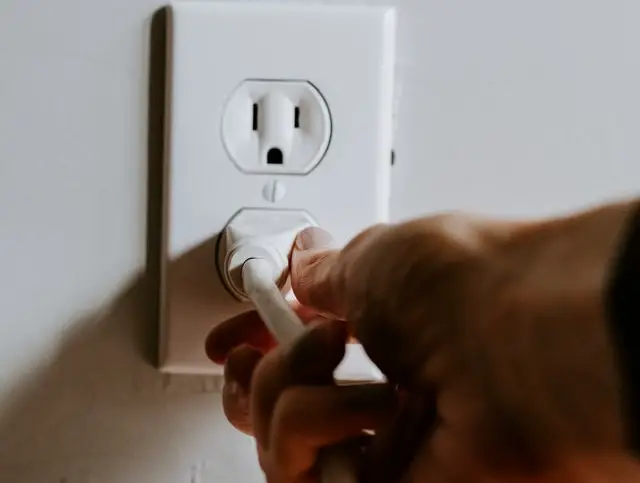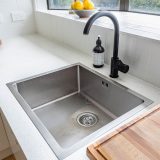How to Unclog a Garbage Disposal

Welcome to my article all about how to unclog a garbage disposal!
A garbage disposal is a handy device to have to grind up food waste so it doesn’t clog your sink drain.
Unfortunately, there is also a chance that your garbage disposal can clog instead, preventing the water in your sink from draining properly.
When this happens, you need to try to remove the clog, which is easier to do than you may think.
Learning how to unclog a garbage disposal can also save you some money since you won’t have to pay for a plumber visit.
Below I’ll go through the top 7 easy ways to unclog your garbage disposal, plus ways to prevent it from clogging in future.
But first, let’s discuss what causes a garbage disposal to clog in the first place.
What Causes a Garbage Disposal to Clog?
Before discussing how to unclog a garbage disposal, let’s take a look at the common reasons for a clog.
The most common is the result of putting the wrong foods down the drain.
There is actually a large list of food to avoid to prevent clogs from happening, including:
- Stringy items that wrap around the blades, like pasta, celery, lettuce, and banana peels
- Hard to chop items, like bones, seeds, and corncobs
- Greasy items that build up, like fats and oils
- Items that grind too small and cause build-ups, like coffee grounds and eggshells
- Starchy items that create a thick paste, like potato peels and beans
Even if you’re putting the right foods down the garbage disposal, you may be trying to cram too many in the drain too quickly.
Overwhelming the garbage disposal prevents it from grinding the food properly since it doesn’t have enough room to move the food around.
Using hot water to rinse the ground food out of the garbage disposal also causes clogs.
Using hot water spreads any grease, oil, or fat around the disposal and the pipes, where it can collect and harden.
This mess will then collect other food items, causing a larger build-up that eventually clogs the drain.
Not using enough cold water to clear the drain after using the garbage disposal can leave food particles behind as well.
How To Unclog A Garbage Disposal: 7 Easy Methods
There are a few different methods for cleaning out a garbage disposal.
We started with the easiest ones and worked our way to the more difficult and time-consuming methods.
Hopefully, you won’t need to try all of them to clear out the clog in your garbage disposal.
Disconnect the Power

The first thing to do when unclogging a garbage disposal is to turn off the power to prevent the device from turning on while you’re working on it.
This includes turning off the switch and even the breaker, just in case the switch isn’t working as it’s supposed to.
You should also avoid putting your hands in the disposal, even with the power turned off.
Look Inside
Once the power is off, take a flashlight and shine it down the drain and into the garbage disposal.
You may be able to see what’s causing the clog this way. If so, insert a pair of tongs or pliers into the garbage disposal and pull out the blockage.
There could be several chunks in there to remove, so clear out as much of it as you can, disposing of them in the garbage.
Once it is clear, turn on the water and run the garbage disposal again.
Use Baking Soda and Vinegar
Combining baking soda and vinegar creates a fizzy liquid that can cut through almost any clog in your garbage disposal.
This mixture also has cleaning properties that wash away any oil, fat, grease, or food particles that have collected in the drain.
To start this method, pour a quarter of a cup of baking soda into your drain and then add half a cup of vinegar.
You can even combine these ingredients first before pouring them down the drain if you like.
Leave the mixture to bubble in the drain for about 20 minutes.
Then turn on the hot water and let it flow down the drain, washing away the baking soda and vinegar mixture, along with any food or other debris that has clogged the drain.
Use a Plunger
If the above methods don’t clear the clog, you may need to try using a plunger to dislodge the clog.
A plunger uses water pressure to loosen and then push the clog down the drain.
Don’t use the flange plunger that you’d normally use to unclog a toilet.
Instead, get a flat plunger since this style will create a better seal on the flat bottom of your kitchen sink.
If there is little to no water in your sink, you’ll need to add enough to cover the bottom of the plunger, which will help with the watertight seal.
Then move the plunger up and down quickly and firmly.
This movement will create enough pressure in the drain to loosen up the clog.
It may take several minutes for this to work.
Once the clog has loosened, look in the drain using a flashlight and remove any visible clog chunks using your tongs or pliers.
Then turn on the cold water to wash the rest of the debris down the drain.
Turn the Blades Manually
Sometimes the disposal blades can be bound up, requiring some manual turning to get them going again.
To do this, locate the hexagon hole on the bottom of the garbage disposal unit and insert a hex wrench into the hole.
Then turn the wrench back and forth a few times until the blades are moving smoothly in both directions.
Look into the drain and remove the chunks of the clog using tongs or pliers.
Wash any smaller pieces down the drain with cold water.
Clean the P-Trap
Sometimes the above methods can’t dislodge a clog in your garbage disposal, so you may need to remove the P-trap and clean out the pipes manually.
Be sure to place a bucket beneath the drain trap to catch any water or debris that comes out when you remove the trap.
Unscrew the slip-nut fittings using some pliers and remove the P-trap.
Look inside of the trap and remove any debris that has collected using a small scrub brush or straightened coat hanger.
If there is none, check in the trap arm, which is the piece that connects the trap to the branch drain pipe, and remove anything that could be clogging this area, again using the brush or wire.
If neither of these areas contain the clog, it may be located in the branch drain, which will require the use of a drain snake to clear it.
Run the auger cable through the branch drain beneath your sink, turning the drum to break up any clogs.
You may need to repeat this process a few times to ensure the drain is clear and ready to use.
Call a Plumber
Unfortunately, there are times when none of the above methods will work.
When all else fails, call a plumbing expert in to locate the clog and clean out your drains.
How to Prevent Future Clogs
To avoid future clogs, there are a few steps you can take.
- Read the instruction manual very carefully since this will contain a list of foods that can and can’t go into it.
- Avoid any of the foods in this list and those we described above.
- Chop up food waste to make the disposal’s job easier.
- Be sure to run the garbage disposal slowly and rinse it with cold water after every use.
How To Unclog a Garbage Disposal: Conclusion
Clogged garbage disposals can unfortunately be a common occurrence.
Using the methods above, you should be able to clear your garbage disposal and get it working smoothly again.
Hopefully, this article will also help you prevent it from getting clogged again in future!
If you enjoyed this article, here are some similar ones you may also like to read:
How To Get Wood Stain Out Of Carpet
How To Get Marker Out Of Carpet

About The Author: Hi, I’m Jessica. I’m a Mom of 2 and I love DIY hacks, home decor ideas and non-toxic cleaning tips. I created this website to share my knowledge with a community of like-minded people who love simple, easy and safe ways to keep their home clean and inspiring. I hope you enjoy!








